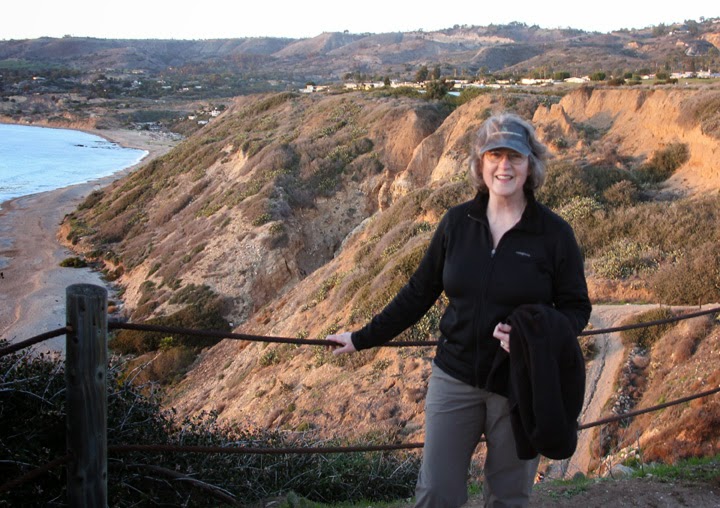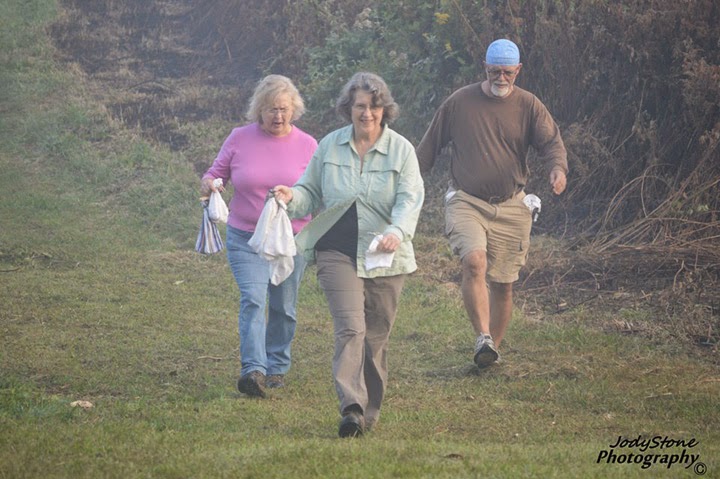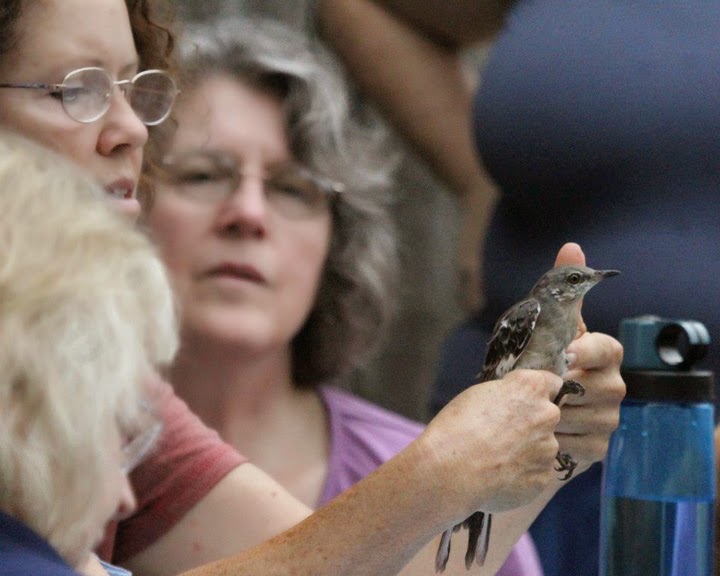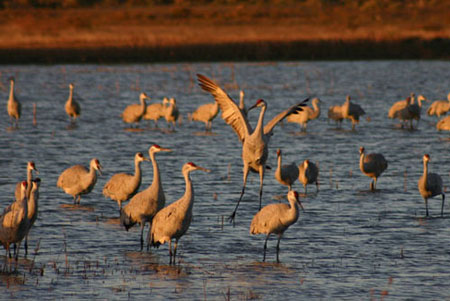 The 2008 ultralight migration class of whooping crane fledglings is on its way to wintering grounds in Florida. Whooping cranes are naturally soaring birds that ride thermals and can make this voyage in as little as nine days. But while these juveniles are learning the migration route, they will only fly in the early morning hours before the thermals rise and while the air is very calm. This is because their surrogate parents are ultralights with costume-clad pilots.
The 2008 ultralight migration class of whooping crane fledglings is on its way to wintering grounds in Florida. Whooping cranes are naturally soaring birds that ride thermals and can make this voyage in as little as nine days. But while these juveniles are learning the migration route, they will only fly in the early morning hours before the thermals rise and while the air is very calm. This is because their surrogate parents are ultralights with costume-clad pilots. Instead of soaring, they will flap their wings and glide, using the vortices from the ultralight wing for lift, or the slight lift from the wings of the bird just in front of them to aid their flight.
Instead of soaring, they will flap their wings and glide, using the vortices from the ultralight wing for lift, or the slight lift from the wings of the bird just in front of them to aid their flight. 

The ultralight migration is now located in Wisconsin and has been grounded a few days due to unfavorable winds for ultralight flying. But some recent photos have been posted that will give you an awesome look at the beautiful plumage of the juveniles, and give you an idea of what its like when the juveniles are let out of their safe enclosure for exercise. You will also see the baggy white costumes worn by pilots and handlers alike, that disguise the human figure enough that our juvenile "ultracranes" do not become accustomed to or feel safe around humans. 

To follow the ultralight migration and its daily ups and downs, visit the Operation Migration field journal. For more of my posts on the ultralight migration, click here.
In my next post I will show you why whooping cranes are not backyard birds.
In my next post I will show you why whooping cranes are not backyard birds.
Linked to Bird Photography Weekly #9, at Birdfreak.com, a weekly photography bird listing to promote bird conservation


 Whooping cranes do not migrate in large flocks of family groups as do sandhill cranes, but rather, they travel in single family units, as solitary individuals or in small bachelor groups.
Whooping cranes do not migrate in large flocks of family groups as do sandhill cranes, but rather, they travel in single family units, as solitary individuals or in small bachelor groups. Subadults that have been driven away by their parents to make room for the next generation of offspring join up in small groups of males and females called bachelor groups. Whooping cranes require 4-5 years to reach breeding maturity. These subadult groupings provide companionship, potential mates and more safety as the young cranes gain survival experience.
Subadults that have been driven away by their parents to make room for the next generation of offspring join up in small groups of males and females called bachelor groups. Whooping cranes require 4-5 years to reach breeding maturity. These subadult groupings provide companionship, potential mates and more safety as the young cranes gain survival experience. Visit the recent posts of
Visit the recent posts of 
 Whooping crane parents bring their chick a variety of foods to teach him what to eat and provide the nourishment he needs for rapid growth.
Whooping crane parents bring their chick a variety of foods to teach him what to eat and provide the nourishment he needs for rapid growth. At ICF's Amoco Whooping Crane Exhibit, I watched as the
At ICF's Amoco Whooping Crane Exhibit, I watched as the 

 A tadpole?
A tadpole? The offering below appears to be a minnow. (You have to look closely.)
The offering below appears to be a minnow. (You have to look closely.)
 Here you see the same chick at four weeks (above and below). Photos by
Here you see the same chick at four weeks (above and below). Photos by  And below, you see the chick at eight weeks. Photo by Sara Zimorski, aviculturists at
And below, you see the chick at eight weeks. Photo by Sara Zimorski, aviculturists at  A young whooping crane chick may grow an average of one inch per day and be ready to fledge sometime between 78-90 days of age. Migration begins mid to late October for most whooping cranes. The juveniles below were photographed in late September and each practice flight increases their strength, endurance and skill at coordinating their seven-foot wing span.
A young whooping crane chick may grow an average of one inch per day and be ready to fledge sometime between 78-90 days of age. Migration begins mid to late October for most whooping cranes. The juveniles below were photographed in late September and each practice flight increases their strength, endurance and skill at coordinating their seven-foot wing span.
 Aren't they amazing?!
Aren't they amazing?!

 it was a wee bit crowded! But that tells us all how much we love our wild places and how important it is to save as many of them as we can.
it was a wee bit crowded! But that tells us all how much we love our wild places and how important it is to save as many of them as we can. The party began when I pulled off the road and took a quiet walk in the woods. I happened upon an area with several dead upright trunks fairly peppered with every size hole imaginable. It felt as though I had just entered a woodpecker dining hall.
The party began when I pulled off the road and took a quiet walk in the woods. I happened upon an area with several dead upright trunks fairly peppered with every size hole imaginable. It felt as though I had just entered a woodpecker dining hall. Within minutes a yellow-bellied sapsucker joined me. He didn't stay long, but I got to see his tail brace in action. The sapsucker is a resident of the park but is described as "seldom seen" until the northern migrants start coming through after the end of September. Then they are more easily seen in the lower elevations.
Within minutes a yellow-bellied sapsucker joined me. He didn't stay long, but I got to see his tail brace in action. The sapsucker is a resident of the park but is described as "seldom seen" until the northern migrants start coming through after the end of September. Then they are more easily seen in the lower elevations.  Wouldn't you just love to know what's happening on the other side of that trunk?
Wouldn't you just love to know what's happening on the other side of that trunk?  The next visitor practically landed on my head--a male red-bellied woodpecker. I was standing inches from the tree he selected which made photography a challenge. But woodpeckers are flighty characters and I enjoyed the few minutes he did stay.
The next visitor practically landed on my head--a male red-bellied woodpecker. I was standing inches from the tree he selected which made photography a challenge. But woodpeckers are flighty characters and I enjoyed the few minutes he did stay.  You don't get this angle very often and I must say, its the closest I've ever been to a woodpecker. I love his white petticoat-style tail that drapes over the black bracing feathers. You just can't get the full effect of this from field guides.
You don't get this angle very often and I must say, its the closest I've ever been to a woodpecker. I love his white petticoat-style tail that drapes over the black bracing feathers. You just can't get the full effect of this from field guides. The white-breasted nuthatch isn't a woodpecker at all, but he fit right into this parade. I heard his 'yank, yank' calls and saw him at a distance before he landed on the other side of this trunk about six feet away. I focused the camera on the trunk, knowing he would pop around to my side at any second. And he did! He gave me these two shots. Don't you just love them? What a treat.
The white-breasted nuthatch isn't a woodpecker at all, but he fit right into this parade. I heard his 'yank, yank' calls and saw him at a distance before he landed on the other side of this trunk about six feet away. I focused the camera on the trunk, knowing he would pop around to my side at any second. And he did! He gave me these two shots. Don't you just love them? What a treat.


 And I'm celebrating birds and migration and I'm celebrating the residents that hang out year round and brighten our world.
And I'm celebrating birds and migration and I'm celebrating the residents that hang out year round and brighten our world. Like the Carolina chickadee.
Like the Carolina chickadee.



 You see why I'm celebrating?
You see why I'm celebrating? The wonderful thing about binoculars is that they bring the bird closer. But I think I love my camera lens the best. It’s when I’m looking at the images on the computer screen that I often see something delightful that I could not have seen before, something I would have otherwise missed…
The wonderful thing about binoculars is that they bring the bird closer. But I think I love my camera lens the best. It’s when I’m looking at the images on the computer screen that I often see something delightful that I could not have seen before, something I would have otherwise missed… like these tiny little feet!
like these tiny little feet! Never mind that the images are fuzzy. Just look at those precious little feet!
Never mind that the images are fuzzy. Just look at those precious little feet! This titmouse is holding its dogwood berry like a squirrel or a mouse might except with straighter toes and unlike the furry critters, he has to perch on these same little feet. Is that not amazing?
This titmouse is holding its dogwood berry like a squirrel or a mouse might except with straighter toes and unlike the furry critters, he has to perch on these same little feet. Is that not amazing? Well, maybe you knew that. But I guess I've never thought about how they hold a berry. I just knew they did. And when I saw these photos all I could do was stare at them and say “look at those little feet!”
Well, maybe you knew that. But I guess I've never thought about how they hold a berry. I just knew they did. And when I saw these photos all I could do was stare at them and say “look at those little feet!” I expected something more like the position below, when the berry's almost gone.
I expected something more like the position below, when the berry's almost gone. But then there's a lot less to hold by now. And he's not planning to leave any behind.
But then there's a lot less to hold by now. And he's not planning to leave any behind.










